Data Cleansing Tools: The Complete Guide to Automated Data Quality (2025)
Automated Data Cleansing: Faster, Smarter, and More Accurate in 2025
Blogby JanJune 14, 2025

Your sales rep just spent 30 minutes researching a prospect only to discover they left the company six months ago. Your marketing team launched a campaign to 10,000 contacts and got a 2% response rate because half the job titles were outdated. Your customer success manager is trying to upsell an account but can't find the decision maker's current contact information.
The culprit? Dirty data.
But here's what most businesses don't realize: while they're burning hours manually fixing data errors, automated data cleansing tools can eliminate 95% of these issues in minutes, not months.
This guide reveals exactly which data cleansing tools turn messy databases into revenue-generating assets, how they work, and which solution fits your specific needs in 2025.
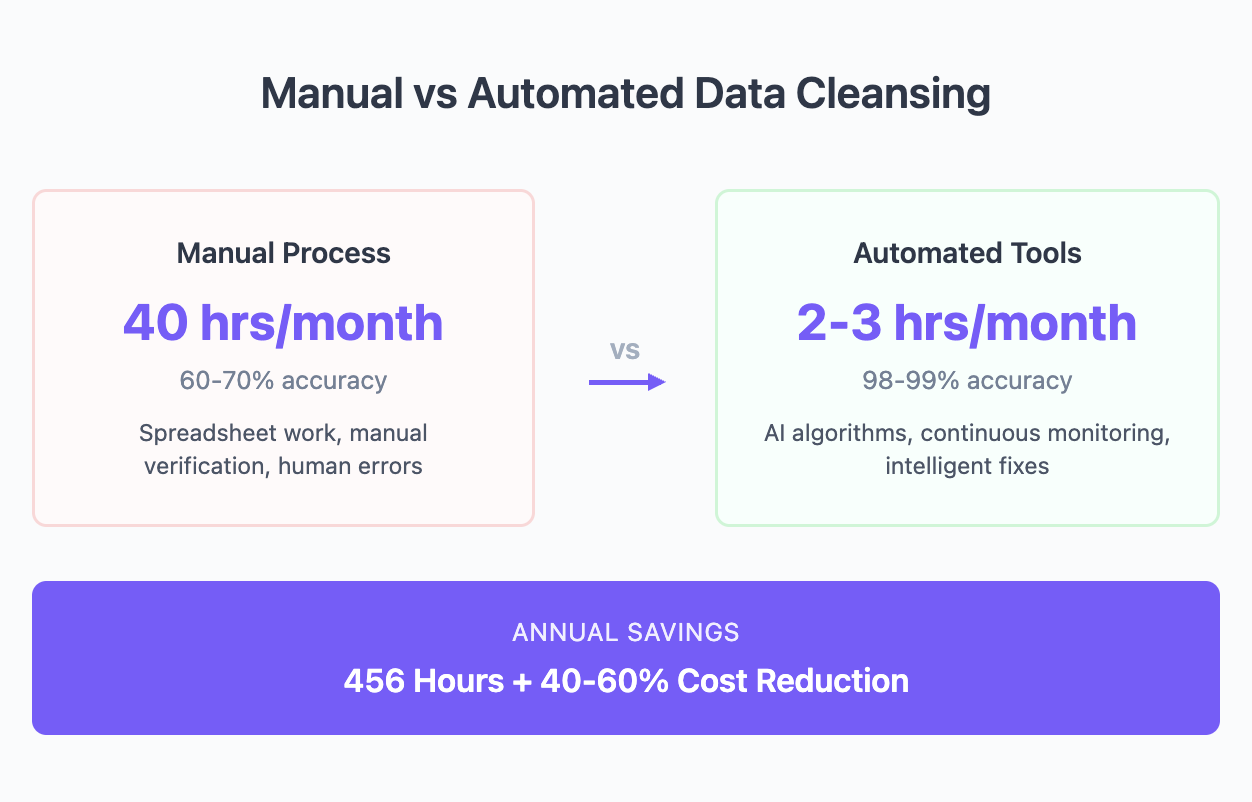
What Are Data Cleansing Tools?
Data cleansing tools are software solutions that automatically detect and fix errors in your business data. Unlike manual processes that require hours of spreadsheet work, these tools use algorithms and AI to identify duplicates, validate information, standardize formats, and maintain data quality across your entire database.
Think of them as quality control systems for your data. Just as manufacturing uses automated inspection to catch defects, data cleansing tools catch and fix data errors before they impact your business.
Modern data cleansing tools go beyond simple find-and-replace functions. They analyze patterns, learn from corrections, and continuously monitor data quality. When integrated with your existing systems, they work silently in the background, maintaining clean data without disrupting your workflow.
The difference between basic data tools and true data cleansing software lies in intelligence. While Excel can find duplicates in a single column, advanced tools can identify that "John Smith at ABC Corp" and "J. Smith at ABC Company Inc." are the same person across multiple databases, even with different email addresses and phone numbers.
Why Your Business Needs Data Cleansing Tools in 2025
Data quality isn't just an IT problem anymore. It's a revenue problem that impacts every department and every decision.
Cost of Manual Data Cleansing
Manual data cleansing kills productivity at scale. Consider these real numbers:
Sales reps waste 27% of their time verifying and updating contact information instead of selling. For a team of 10 reps earning $80,000 annually, that's $216,000 in lost productivity every year.
Marketing teams see email deliverability plummet when databases contain outdated information. With email marketing generating an average ROI of $42 per dollar spent, a 10% increase in bounce rate can cost thousands in lost revenue.
IT departments allocate significant resources to data maintenance. Enterprise organizations spend an average of $9.7 million annually on data quality issues, with much of that going to manual cleanup efforts.
Customer service suffers when agents work with conflicting information. Research shows that 67% of customers switch brands due to poor experiences, often caused by data inconsistencies.
ROI of Automated Data Cleansing Tools
The numbers speak for themselves when businesses switch to automated data cleansing tools:
Time savings: Tasks that took 40 hours monthly drop to 2-3 hours of oversight. That's 456 hours saved annually per employee involved in data management.
Accuracy improvements: Automated tools achieve 98-99% accuracy rates compared to 60-70% for manual processes. This dramatic improvement directly impacts campaign performance and customer satisfaction.
Cost reduction: Companies report 40-60% reductions in data management costs after implementing automated solutions. The savings come from reduced labor, fewer errors, and improved efficiency.
Revenue impact: Clean data drives better results. Businesses using automated data cleansing tools report 15-25% improvements in campaign response rates and 20-30% faster sales cycles.
Types of Data Cleansing Tools
The data cleansing tools market offers solutions for every business size and need. Understanding the categories helps you choose the right fit.
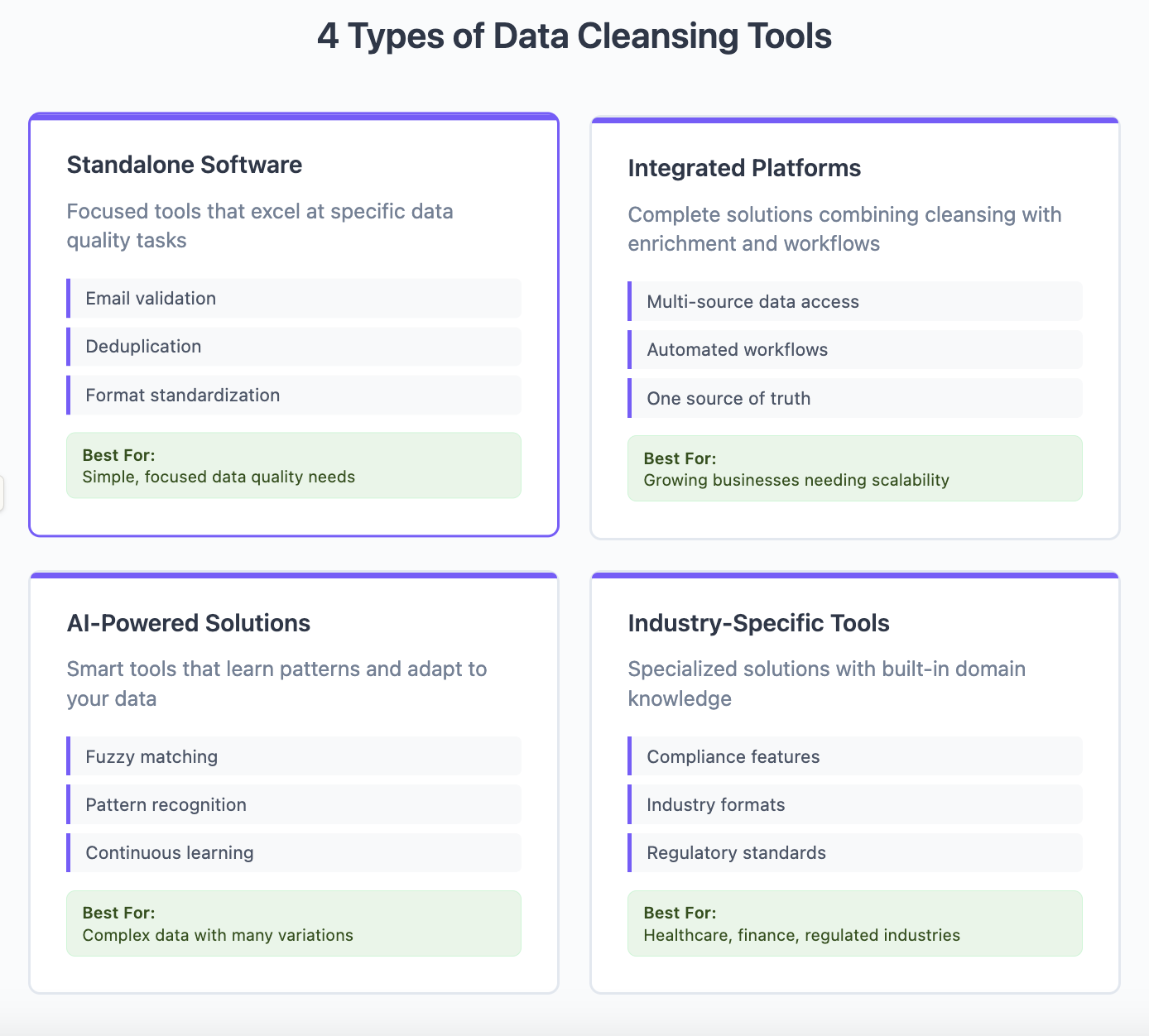
Standalone Data Quality Software
Standalone tools focus exclusively on data quality. They excel at specific tasks like deduplication, validation, or standardization.
These solutions work well for businesses with straightforward needs. If your primary challenge is duplicate contacts or format standardization, standalone tools deliver focused functionality without unnecessary complexity.
Popular standalone options specialize in different areas. Some excel at email validation, achieving 99% accuracy in identifying invalid addresses. Others focus on deduplication, using sophisticated matching algorithms to identify duplicates even with significant variations.
The main advantage: simplicity and depth. Standalone tools do one thing exceptionally well. The limitation: you might need multiple tools for comprehensive data cleansing.
Integrated Data Management Platforms
Integrated platforms combine data cleansing tools with broader data management capabilities. They handle everything from initial data import through enrichment, cleansing, and integration with other systems.
Platforms like Databar.ai exemplify this approach. Instead of just cleaning existing data, they provide access to 90+ data providers for enrichment while maintaining quality through automated workflows. This integration eliminates the traditional boundaries between finding, cleaning, and enriching data.
The integrated approach offers several advantages. Data flows seamlessly between functions without import/export cycles. Workflows can combine cleansing with enrichment in single processes. Most importantly, you maintain one source of truth instead of synchronizing multiple tools.
For growing businesses, integrated platforms provide scalability. Start with basic cleansing, then add enrichment, automation, and advanced workflows as needs evolve.
AI-Powered Data Cleansing Solutions
Artificial intelligence transforms how data cleansing tools identify and fix errors. Instead of rigid rules, AI learns patterns and adapts to your specific data.
AI excels at fuzzy matching - recognizing that "International Business Machines" and "IBM" represent the same company. It identifies patterns humans miss, like systematic errors in data entry or import processes.
Machine learning algorithms improve accuracy over time. They learn from corrections, becoming more effective at identifying similar issues. This continuous improvement means your data quality increases automatically.
Natural language processing enables AI to understand context. It can determine whether "Apple" refers to the technology company or the fruit based on surrounding data, eliminating errors that rule-based systems miss.
Industry-Specific Data Cleansing Tools
Some industries face unique data challenges requiring specialized solutions. Healthcare must maintain HIPAA compliance while cleansing patient records. Financial services need tools that understand complex entity relationships and regulatory requirements.
Industry-specific data cleansing tools build in this domain knowledge. They understand that a slight name variation might indicate fraud in banking but represent a common occurrence in healthcare.
These tools also incorporate industry-standard formats and validations. A healthcare-focused tool knows valid NPI numbers and ICD-10 codes. A financial services tool understands CUSIP identifiers and regulatory reporting requirements.
The trade-off: specialized tools excel within their domain but lack flexibility for general business data. Choose them when industry requirements outweigh general functionality.
Key Features to Look for in Data Cleansing Tools
Not all data cleansing tools are created equal. The right features determine whether a tool solves your problems or creates new ones.
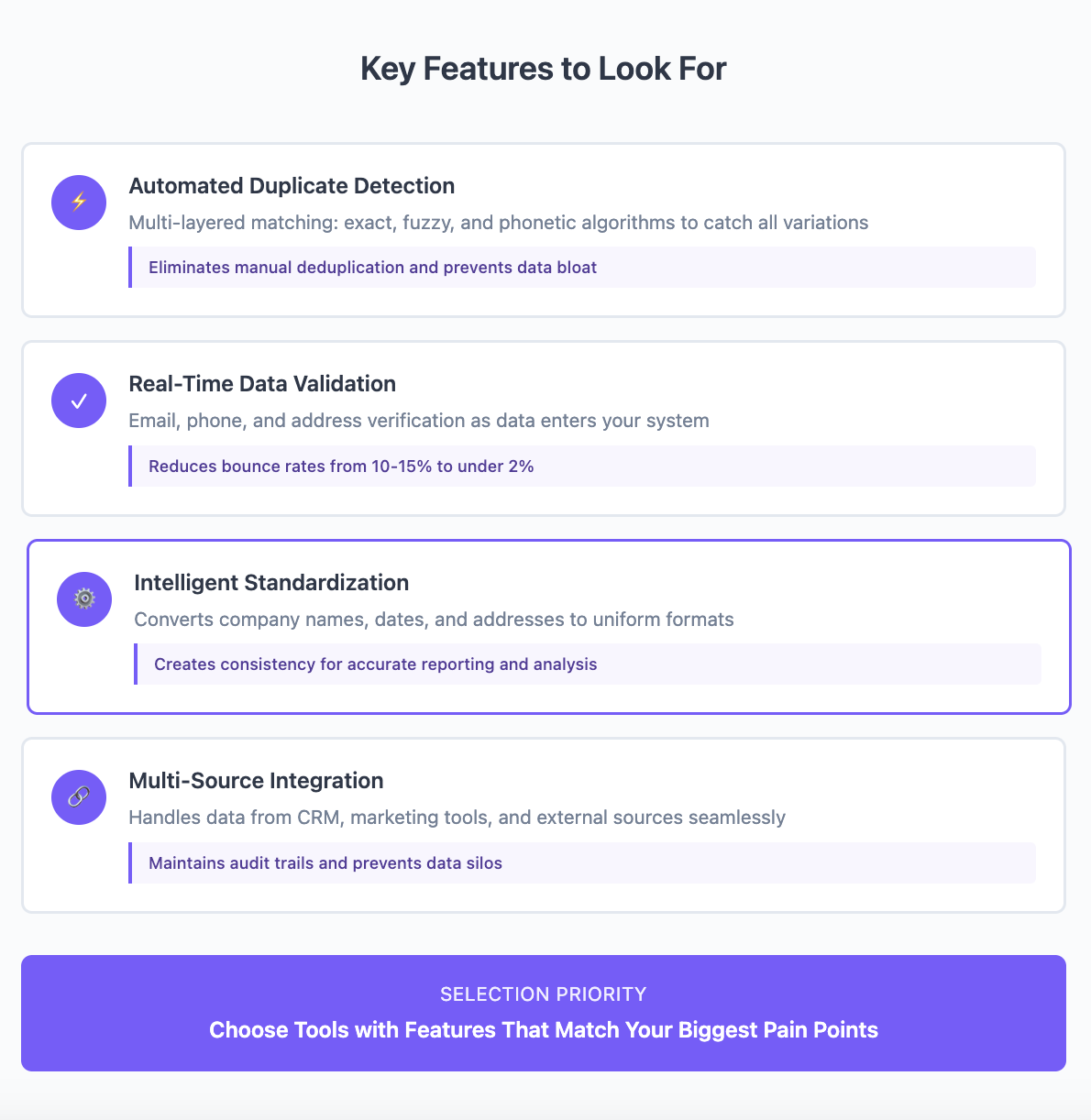
Automated Duplicate Detection
Duplicate detection goes far beyond matching exact copies. Advanced data cleansing tools use multiple matching strategies:
Exact matching catches identical records, but that's just the beginning. Fuzzy matching identifies records with slight variations - misspellings, abbreviations, or format differences. Phonetic matching catches names that sound similar but spell differently.
The best tools combine these approaches. They might use exact matching for email addresses, fuzzy matching for company names, and phonetic matching for personal names. This multi-layered approach catches duplicates that single-method systems miss.
Customization matters too. Your business might consider records duplicates based on email address alone, while another needs matching addresses and phone numbers. Look for tools that let you define duplicate criteria based on your specific needs.
Real-Time Data Validation
Catching errors at entry prevents problems from propagating through your systems. Real-time validation in data cleansing tools acts as a gatekeeper, ensuring only clean data enters your database.
Email validation goes beyond checking format. Advanced tools verify domain existence, check MX records, and even ping mail servers to confirm deliverability. This comprehensive validation can reduce bounce rates from 10-15% to under 2%.
Phone validation includes format checking, country code verification, and carrier lookup. Some tools can identify mobile versus landline numbers, helping you choose appropriate communication channels.
Address validation standardizes formats while verifying deliverability. Integration with postal databases ensures addresses match official records, crucial for physical mail campaigns and accurate territory assignment.
Intelligent Data Standardization
Consistency creates value in data. Data cleansing tools with intelligent standardization transform chaotic data into uniform, analyzable information.
Company name standardization exemplifies the challenge. "Microsoft", "Microsoft Corp.", "Microsoft Corporation", and "MSFT" all represent the same entity. Intelligent tools recognize these variations and standardize according to your preferences.
Date standardization prevents confusion between formats. Is 01/02/03 January 2, 2003, February 1, 2003, or February 3, 2001? Tools automatically detect and convert to your standard format.
Geographic standardization ensures consistency in addresses, states, and countries. Whether someone enters "CA", "Calif.", or "California", your data maintains uniform formatting.
Multi-Source Data Integration
Modern businesses pull data from dozens of sources. Your CRM, marketing automation, support tickets, and purchased lists all use different formats and standards. Data cleansing tools must handle this diversity.
Look for tools supporting common formats: CSV, Excel, JSON, XML, and direct database connections. API access enables real-time integration with your existing systems.
More importantly, tools should maintain data lineage - tracking where information originated and how it changed. This audit trail proves invaluable for troubleshooting and compliance.
The best solutions handle conflicts intelligently. When the same contact appears in multiple sources with different information, tools should merge records according to your business rules, not arbitrary defaults.
How Data Cleansing Tools Work
Understanding the process helps you maximize value from data cleansing tools. While interfaces vary, most follow similar workflows.
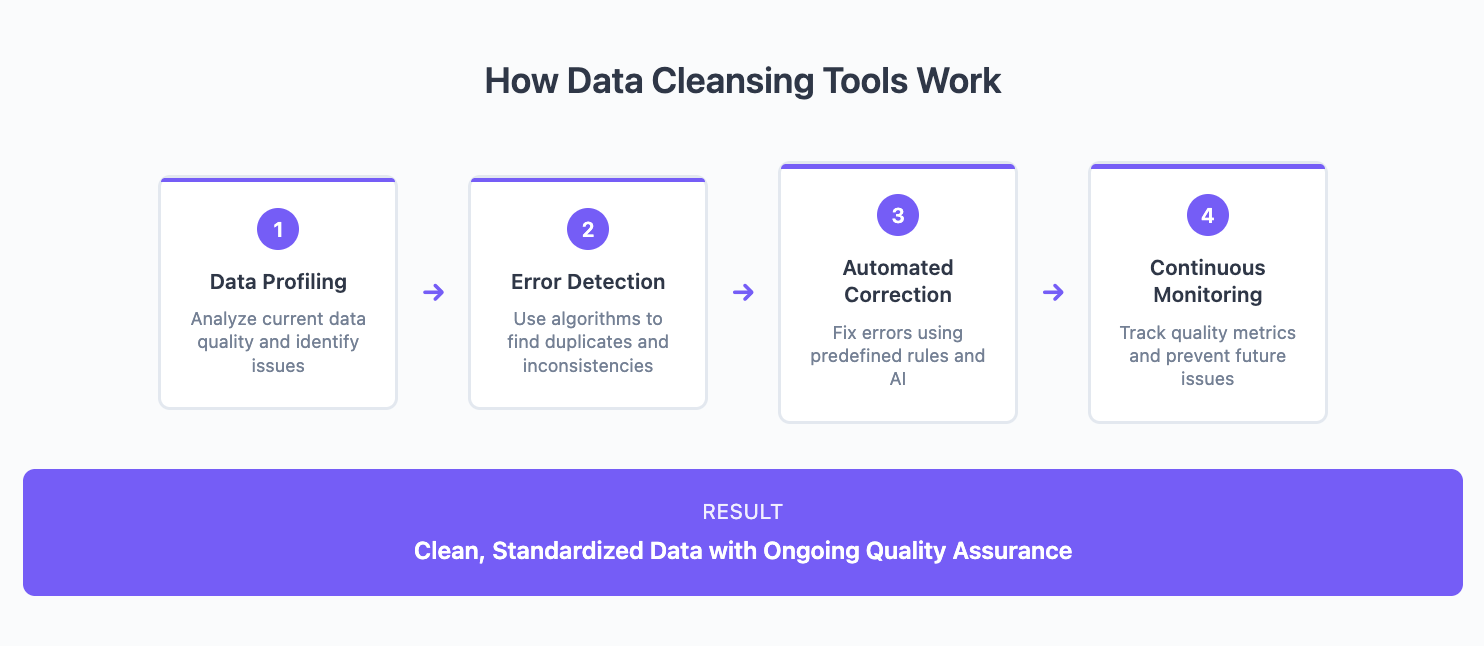
Data Profiling and Analysis
Before cleaning begins, tools analyze your data to understand its current state. This profiling reveals the scope of quality issues and guides cleaning strategies.
Profiling examines completeness - how many records lack required fields. It identifies format variations, showing that phone numbers appear in 15 different formats across your database. Statistical analysis reveals outliers that might indicate errors.
Pattern recognition identifies systematic issues. If 30% of email addresses from one source follow an invalid format, that suggests an import error requiring bulk correction rather than individual fixes.
This analysis phase often reveals surprises. Companies frequently discover they're missing critical data for 40-50% of records, or that assumed-unique identifiers contain thousands of duplicates.
Error Detection Algorithms
Data cleansing tools employ sophisticated algorithms to identify errors humans would miss. These aren't simple spell-checkers but intelligent systems understanding data context.
Validation algorithms check data against known standards. Email addresses must follow RFC specifications. Phone numbers must match country-specific formats. Postal codes must correspond to actual locations.
Anomaly detection identifies outliers. If most customers have order values between $100-$1,000, a $100,000 order might indicate a decimal point error. Birth dates in the future or ages over 150 flag as obvious errors.
Cross-field validation ensures consistency. If a record shows a U.S. state but a UK postal code, that inconsistency triggers correction workflows.
Automated Correction Workflows
Detection without correction wastes time. Modern data cleansing tools fix many errors automatically while flagging ambiguous cases for review.
Standardization corrections happen automatically. The tool converts all variations of "United States" to your preferred format without manual intervention. Phone numbers reformat to consistent patterns. Dates align to standard formats.
For ambiguous corrections, tools present options. When merging duplicates with conflicting information, you might choose the most recent data, the most complete record, or manually select field by field.
Bulk operations accelerate corrections. Instead of fixing errors individually, apply rules across entire datasets. "Convert all country codes to full names" executes in seconds across millions of records.
Continuous Monitoring Systems
Data quality isn't a one-time project. The best data cleansing tools monitor continuously, catching issues before they impact operations.
Monitoring dashboards show quality metrics in real-time. Track duplicate rates, completeness percentages, and validation failures. Sudden spikes indicate problems requiring attention.
Automated alerts notify you of quality degradation. If import processes suddenly generate 10x normal error rates, you'll know immediately rather than discovering problems weeks later.
Scheduled cleansing maintains quality without manual intervention. Run deduplication weekly, validation daily, and comprehensive audits monthly. Your data stays clean without constant oversight.
Choosing the Right Data Cleansing Tool for Your Business
Different roles and industries have unique data cleansing needs. The perfect tool for a small sales team might frustrate enterprise data managers.
For Sales Teams
Sales teams need data cleansing tools that integrate seamlessly with CRM systems and don't disrupt selling activities. The focus should be on contact data quality and accessibility.
Look for tools that clean data within your CRM interface. Salespeople shouldn't need separate logins or complex workflows. One-click deduplication and inline validation keep data clean without leaving familiar screens.
Prioritize contact-focused features. Email validation, phone number formatting, and company standardization directly impact outreach success. Advanced features like address validation matter less if you're not shipping physical products.
Real-time enrichment during cleansing adds value. As tools validate email addresses, they can simultaneously append missing phone numbers or update job titles. This combination of cleaning and enrichment maximizes each record's value.
Consider mobile accessibility. Sales reps working from phones and tablets need tools that function everywhere, not just desktop computers.
For Marketing Operations
Marketing operations teams juggle data from multiple sources while maintaining compliance and attribution. Their data cleansing tools must handle complexity at scale.
Integration breadth matters most. Marketing data comes from web forms, events, partners, and purchases. Tools must ingest, clean, and standardize data regardless of source.
Segmentation capabilities enhance value. Clean data enables precise targeting, but only if tools maintain segment integrity during cleansing. Preserve custom fields and tags while standardizing core information.
Compliance features protect your business. GDPR, CCPA, and industry regulations require careful data handling. Tools should track consent, manage opt-outs, and provide audit trails for all changes.
Performance at scale determines success. Marketing databases often contain millions of records. Tools must process large volumes quickly without disrupting campaign execution.
For Enterprise Data Management
Enterprise data teams need data cleansing tools that govern data across entire organizations. Security, scalability, and integration complexity take precedence.
Role-based access controls prevent unauthorized changes. Different teams should see and modify only appropriate data. Audit trails must track who changed what and when.
API-first architecture enables integration with existing enterprise systems. Whether connecting to SAP, Oracle, or custom applications, tools must fit your technology stack.
Scalability goes beyond volume. Enterprise tools must handle multiple entities, currencies, languages, and regulatory requirements. What works for North American operations must extend globally.
Change management features ease adoption. Enterprise deployments affect hundreds or thousands of users. Tools should support gradual rollouts, training modes, and change tracking.
Improve Your Data Quality with Intelligent Automation
Poor data quality isn't just a technical problem - it's a revenue killer that impacts every corner of your business. While competitors struggle with manual processes and disconnected tools, you could be leveraging intelligent data cleansing tools that transform messy data into competitive advantage.
Databar.ai makes data cleansing easy by combining it with enrichment in one unified platform. Unlike traditional tools that only fix existing data, Databar.ai simultaneously cleans, validates, and enriches your records using 90+ premium data providers.
Here's what sets Databar.ai apart:
✅ All-in-one platform: Cleanse, enrich, and automate in one place - no more juggling multiple tools
✅ 90+ data providers: Access premium data sources without separate subscriptions
✅ Intelligent workflows: Build complex cleansing logic without writing code
✅ Real-time processing: Clean data as it enters your system, not in overnight batches
✅ Seamless integrations: Connect directly to your CRM, marketing automation, and sales tools
✅ AI-powered segmentation: Standardize data with advanced algorithms
The result? Sales teams see 25-40% improvements in contact rates. Marketing achieves 2-3x better campaign performance. And your entire organization saves thousands of hours previously wasted on manual data tasks.
Ready to see how automated data cleansing transforms your business? Start your free Databar.ai trial today!
FAQs About Data Cleansing Tools
What's the difference between data cleansing and data enrichment? Data cleansing fixes errors in existing data - removing duplicates, correcting formats, and validating information. Data enrichment adds new information to records, like appending phone numbers or updating job titles. Modern platforms like Databar.ai combine both processes, cleaning data while simultaneously enriching it for maximum value.
How long does data cleansing take? Implementation timelines vary by data volume and complexity. Initial setup of data cleansing tools typically takes 1-2 weeks. First cleansing runs process 10,000-50,000 records per hour, depending on the operations performed. Ongoing cleansing happens continuously in real-time or through scheduled batch processes.
Can data cleansing tools handle unstructured data? Most data cleansing tools focus on structured data in databases and spreadsheets. However, advanced AI-powered solutions increasingly handle semi-structured data from sources like social media, emails, and documents. They extract structured information for cleansing while preserving original context.
Related articles
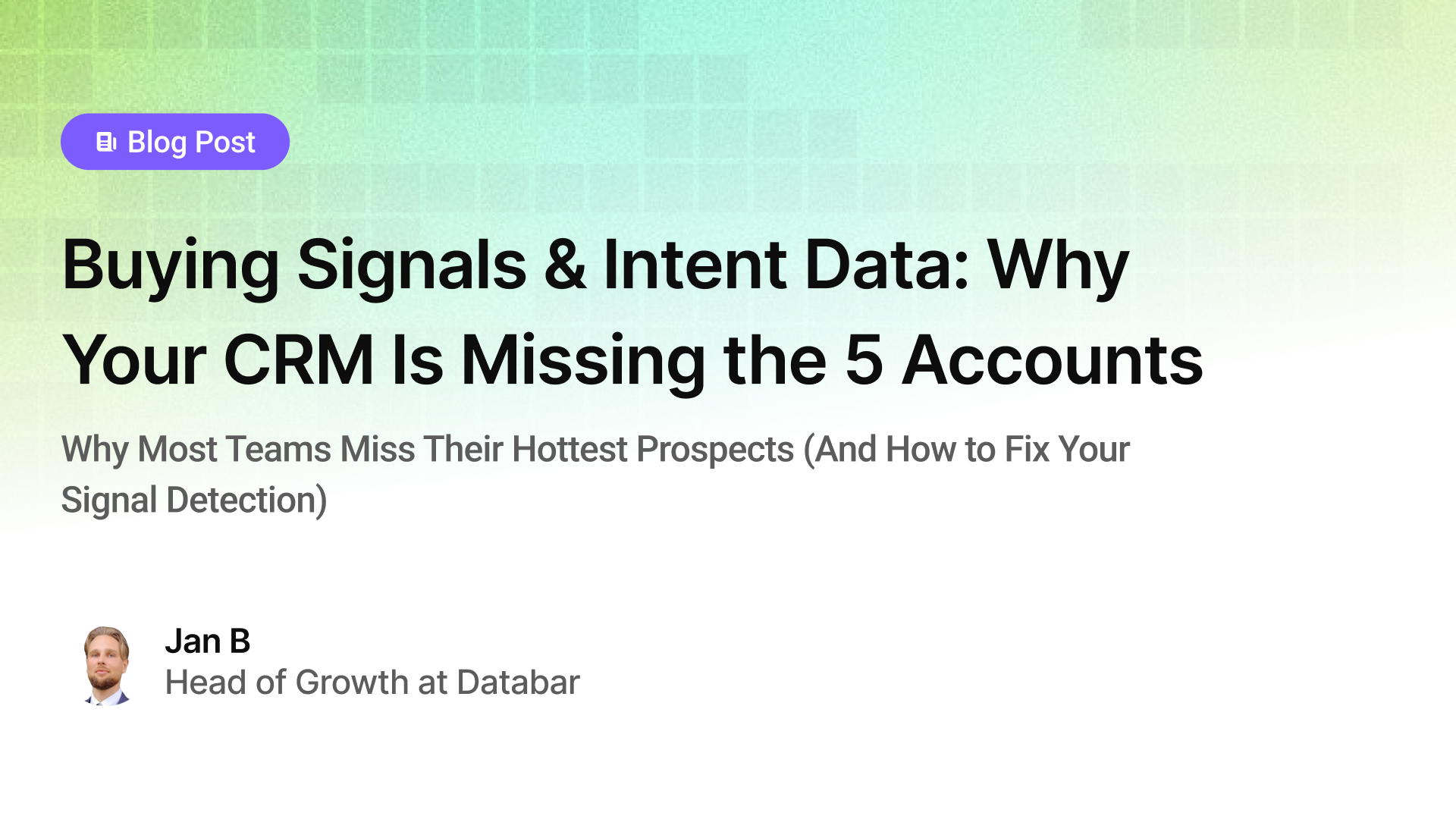
Buying Signals & Intent Data: Why Your CRM Is Missing the 5 Accounts
Why Most Teams Miss Their Hottest Prospects (And How to Fix Your Signal Detection)
by Jan, October 06, 2025

Lead Scoring & Account Segmentation: Why Most CRMs Get This Backward (And How to Fix It)
How to build a system that tells your team who to call, when, and why
by Jan, October 06, 2025
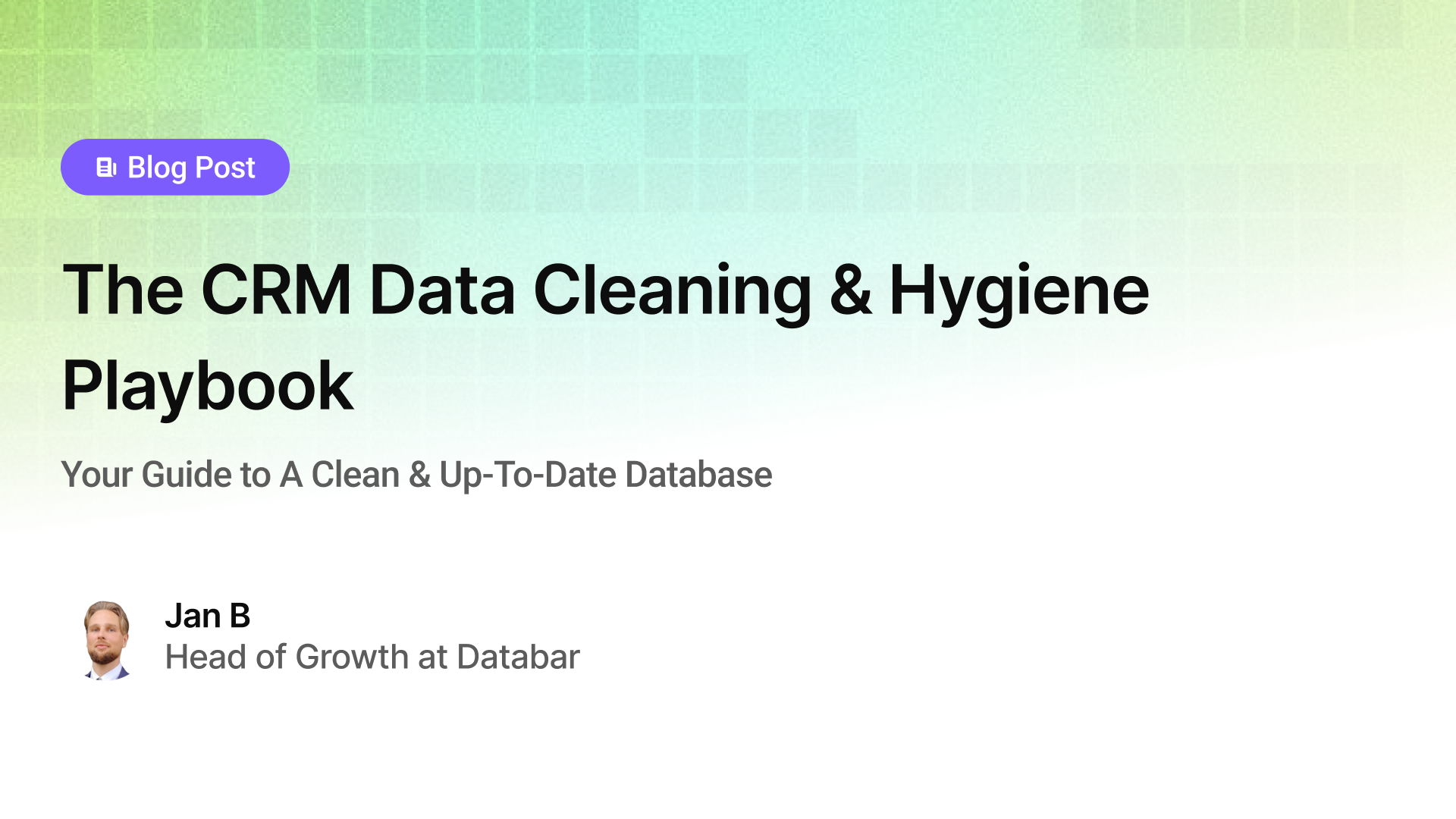
The CRM Data Cleaning & Hygiene Playbook
Your Guide to A Clean & Up-To-Date Database
by Jan, October 04, 2025
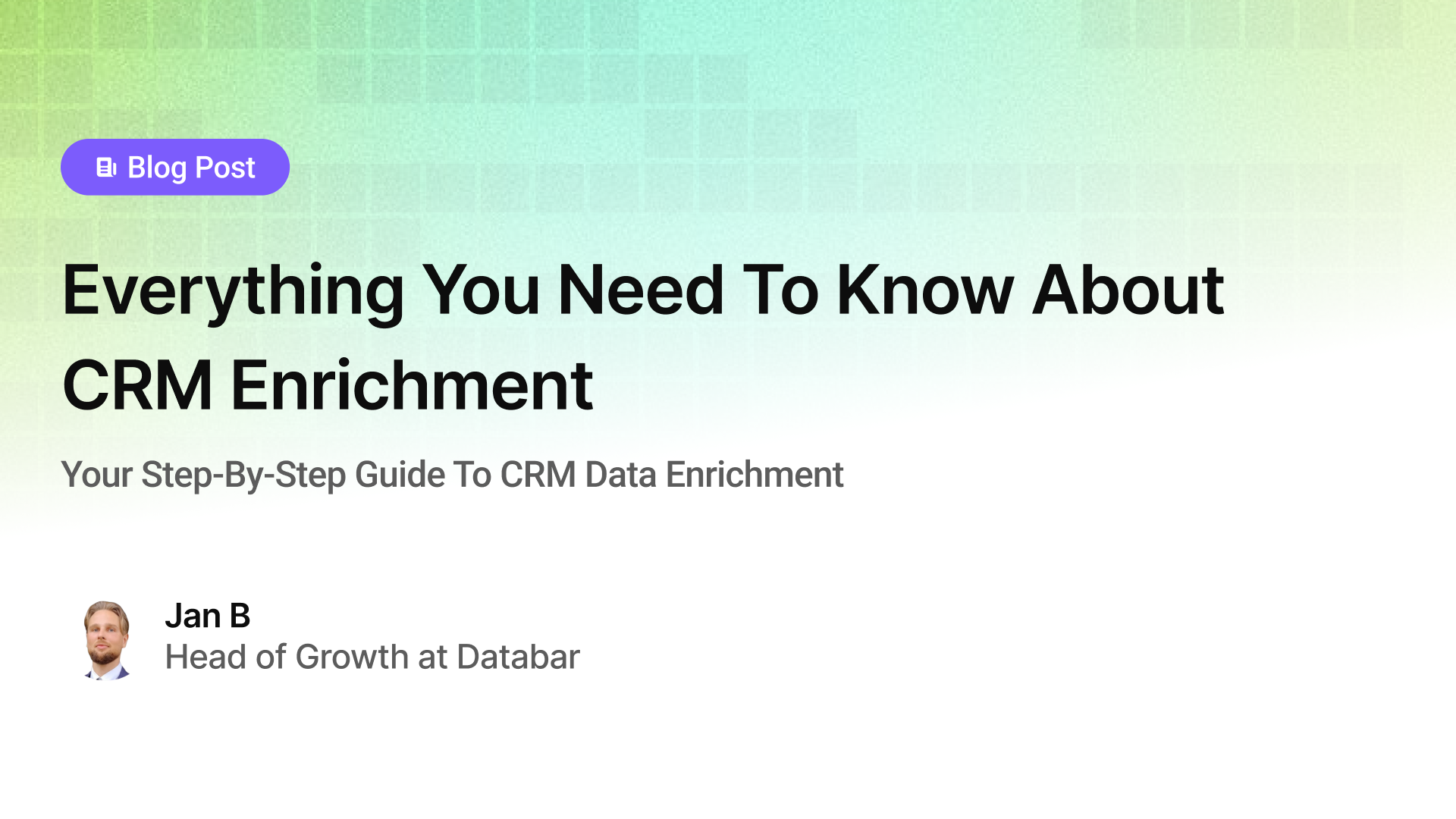
Everything You Need To Know About CRM Enrichment
Your Step-By-Step Guide To CRM Data Enrichment
by Jan, October 03, 2025